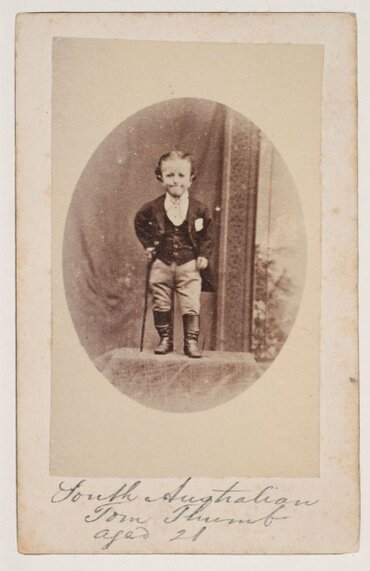John Morcom - Monsieur Vertelli on the Wire
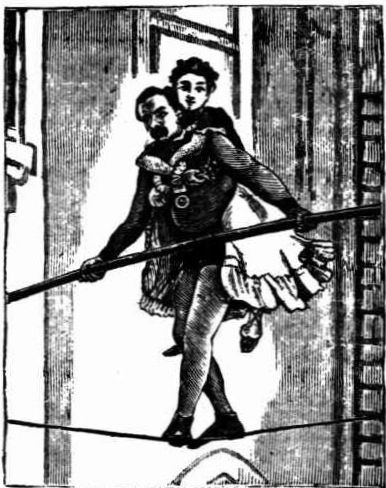
Many of these stories of early magicians in Australia have a commonality. The performer often arrived from foreign lands, hid behind a pseudonym, travelled with a repertoire of standard tricks such as the Inexhaustible Bottle and the Gun Trick, and may have had other private business pursuits or jobs which meant their whereabouts at certain times cannot be tracked.
Monsieur Vertelli has the attraction of having grown up in Australia and we can track his heritage. He ventured into new effects of magic and travelled to a land few other magicians had seen. His occupation as a magician was secondary to his main fame as a trapeze artist and wire-walker.
As this site's focus is always on the performance of magic within Australia, we will only refer to other skills, and other countries, in abbreviated form. There is much more which could be written about Vertelli.
Vertelli on the Wire - said to be taken from a photograph made in the 1860s
at the Town Hall, Adelaide.
Published in obituary, The Mail, Adelaide, Feb.21 1914
at the Town Hall, Adelaide.
Published in obituary, The Mail, Adelaide, Feb.21 1914
Wire-Walking and Trapeze
The skill of walking along a taut rope or, in later times, a wire cord, is an ancient one, known even from early Greece. The version of swinging or "flying" trapeze known to us today is a younger form of acrobatics, and the 1859 artistry of Jules Leotard (that daring young man on the flying trapeze) is generally regarded as the start of a craze for trapeze work, which would eventually evolve into a staple of the Circus, along with equestrian and other acrobatic displays.
In Australia, aside from our subject Vertelli, the middle 1860s were filled with exponents of these spectacular stunts, including Harry L'Estrange, famous visitor Charles Blondin, the Wieland 'Brothers' (who came to Australia courtesy of magician Robert Osborne), Ella Zuila, and members of the "Leotard Troupe" which, though named after the originator, were unrelated performers from Australia. (1) In later years the "Wizard of the Wire", Con Colleano (1899 - 1973), would export his talents from Australia to the world. (1a)
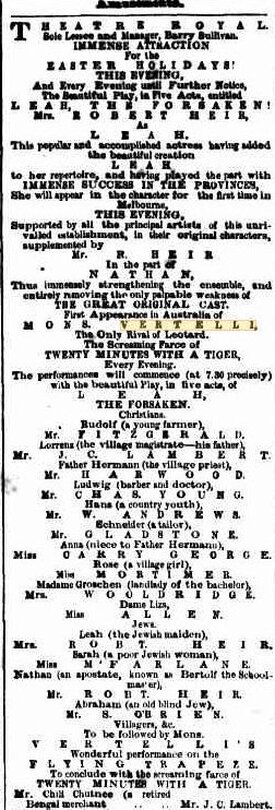
John "Vertelli" Morcom and Family
The Morcom family have a varied history which extended family research (2) covers in more detail. Samuel Morcom arrived from Cornwall, England, in September 1847 aboard the "Rajah", as a mining captain in charge of a large contingent of miners and their families, over 200. Initially mining for copper at Reedy Creek, South Australia, after five years vast goldfields opened up and the miners departed in search of gold. Samuel became a goldfields commissioner for some time but then moved to Hindley Street, Adelaide where he purchased a hotel and named it "Morcom's Temperance Hotel", providing food and accommodation for incoming migrants; he lived there until his death on April 12, 1891. It may be that Samuel's Quaker background was the motivating force behind his childrens' excellence in physical activities.
His oldest sons, John and James (mother Mary, nee Toy) are the focus of this story. They were born at Tin Croft, near Pool in Cornwall and followed Samuel out to Australia in 1849 or 1850. John's birthdate is given as June 12, 1840, James being born December 16, 1844. Other siblings were Mary, Samuel, Thomas and William.
A schoolteacher, Mr Leschen, had a horizontal bar and single trapeze set up in his back yard, and James would later recall (3) making his first ventures into gymnastics there. John is said (4) to have learned his skills in acrobatics and tight rope walking at Joe Worley's Adelaide gymnasium. Worley, an expert slack-rope walker often carried his students on his back across a tight wire, and some of his students joined Burton's circus and toured Australia. John's first occupation was as the owner of a cooperage (barrel maker) in Bank Street, Adelaide, (20) where he had a practice rope connected to the beams of his building.
John Morcom would also have been inspired by the visits to Adelaide of numerous trapeze and gymnast groups, including Bartine, the Wielands, the Leotard Troupe, the St. Leon Troupe and the Lenton troupe, all before 1865.
According to family research on Morcom (see reference 20), his new stage name, Monsieur or Signor Vertelli, was adapted from a guest at his father's Temperance Hotel, Dr Horatio Thomas Whittell, who was a temperance lecturer and close friend of the family.
The earliest notice we find of John Morcom is in November 1864, (5) when he suspended a cross-bar from ropes on a building, and swung and turned two somersaults before landing in some water below. Clearly he was intent on a career, for by April 1865 he was a featured performer in a long variety bill at the Melbourne Theatre Royal. Already billed as "Mons. Vertelli, the only rival of Leotard" his act was on the flying trapeze and, so it was claimed, he was paid £100 a week for two weeks by the producer, Barry Sullivan. The Herald of November 18 said, "Signor Vertelli, who possesses a handsome figure and an intelligent face, performed the flying trapeze feats, a la Leotard, to the general satisfaction."
August 24 saw Vertelli make a 100-foot wire walk across the top of the falls at Mount Lofty (south east of Adelaide). Walter Hart, an engraver, created a wood engraving of the stunt, supposedly based on a photograph taken by Richard Hall of Adelaide. (6) It was published in the Illustrated Melbourne Post, but another illustration exists (Mitchell Library, State Library of New South Wales), in pen and wash, apparently based on Hart's engraving but attributed to "a sketch by W.A.Cawthorne". It was criticised by the 'Register' as being "neither truthful nor spirited".
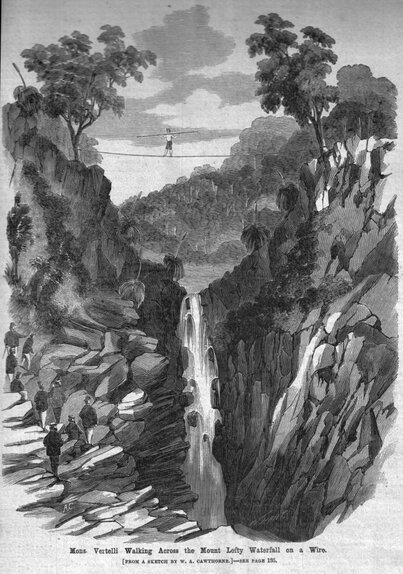
In May, Vertelli was at Ballarat's Charlie Napier theatre with trapeze work including turning his suspension from the knees to the arms. The Ballarat Star indicated that perhaps he lacked some of the sang froid of other workers, but still praised his work.
September saw the Leotard Troupe including George and Edwin in their "Leap for Life", and notably a version of an early challenge escape trick with rope, "The Great Davenport Trick", which may have piqued Vertelli's interest in magic.
Interestingly, towards the end of the Leotards' season, one of their advertisements was suffixed with an announcement by Samuel Morcom - GYMNASTICS - CAUTION to the Lovers of this Dangerous Science. - Copied from the Northern Ensign June 8:- "Leotard the accomplished performer on the trapeze, has at length performed once too often. He has had a bad fall at Madrid and broken his leg." S. Morcom, Temperance Hall September 18, 1865.
Not long before this, Vertelli had gotten into a scrape with Edwin Leotard. Vertelli had asked for Edwin's opinion of his performances at the Theatre Royal, and was unhappy with the response that his feats were well done on the first night, but failed several times on the next. Vertelli punched Leotard in the eye, and ended up being fined £5 for assault. All other considerations aside, it seems that Vertelli gradually placed less promotional emphasis on trapeze work, and more on his tight-rope walking. By December he was in Sydney advertising a Rope Ascent at Manly Beach.
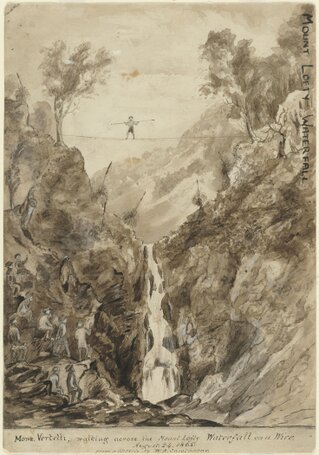
Vertelli began the year 1866 at Sydney's Prince of Wales Theatre walking a wire stretched from the top of the dress circle to the edge of the stage. He performed an ascent at Parramatta Domain while blindfolded, and from there the newspapers are full of reports as he moved northwards through Newcastle and the Hunter region as far up as Newcastle. In April he wheeled a barrow across the falls at Dangar's Gorge south of Armidale, 500 feet above the ground and with a stiff breeze blowing. The feat inspired Bill Dangar, a descendant of the pioneer Henry Dangar, to create in 2015 a monument to Vertelli, showing him crossing the Gorge with a pole, a large golden heart embedded in a body shape made of welded squares. (7) Vertelli continued his travels northwards throughout Queensland, and returned to Sydney in December 1866.

1867 saw Vertelli in Tasmania, in Launceston and Hobart, still seeking out suitable exhibition sites for his wire walking, and still exhibiting on the Trapeze. He encountered some early problems which made for poor publicity; in February his wire collapsed and the press initially reported it as "insecurely erected". A letter to the editor from an eyewitness later said that "several boys and still greater Arabs which infest this town were tampering with the rope and thereby caused the accident."
In March, Vertelli was to have walked across the bay at Hobart from Rosny to Kangaroo Point, but despite having an audience of 800 people, the walk did not take place, as the wire could not be properly stretched and secured. In a letter to the Cornwall Chronicle (March 23) Vertelli claimed that the criticism levelled at him on both occasions was because the Hobart Mercury had taken a dislike to him, after he refused to give free passes to friends of the Mercury staff.
Vertelli returned to Melbourne and the Theatre Royal, where he had another near-miss in May when a guide wire broke while he was ascending (blindfolded) with a wheelbarrow, and only his presence of mind prevented his falling.
NEW ZEALAND
By late July 1867 , John Morcom had packed his bags and shipped across to New Zealand where, on July 26, he appeared at the City Theatre, Hokitika. For the next eight months, sometimes billed as "Jean Vertelli the Australian Blondin" he toured with great success around all the major townships, featuring his wire ascent, walking backwards and forwards while blindfolded, wheeling his barrow along the rope, and other gymnastic feats which appear to still include the trapeze.
A young protégé, usually referred to as "Eugene" (male) or "Eugenie" (female) appeared with Vertelli, and Eugene seems to have been a juvenile contortionist while Eugenie had wirewalking skills. Another performer on the bill in December was Mons. Selbani , performing feats of strength such as bending a solid metal bar; his other skills such as "fire tubes" and "feats with feathers" are mentioned, though there is no apparent connection to any performance of magic.
Vertelli's major walk in New Zealand was crossing the 900 foot distance across the Wanganui River in October, at the lower ferry wharf (and probably across the existing ferry cable), with his wheelbarrow. At one stage he asked his spectators to be allowed to carry one of them over on his back, but his entreaties fell on deaf ears.
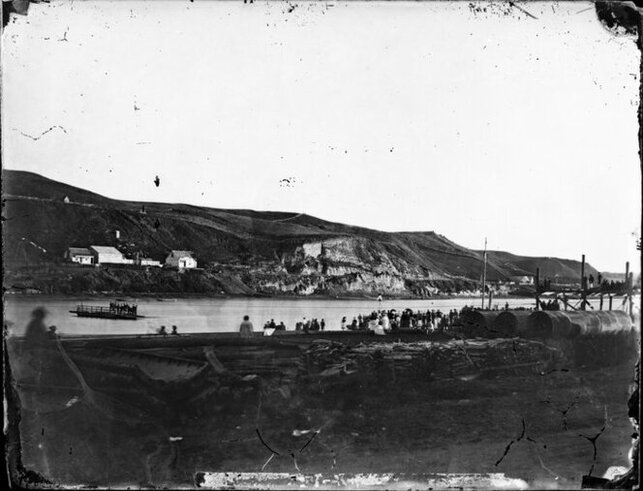
Photos by William James Harding of Vertelli's crossing at Wanganui, October 31, 1867. https://natlib.govt.nz/records/23174705
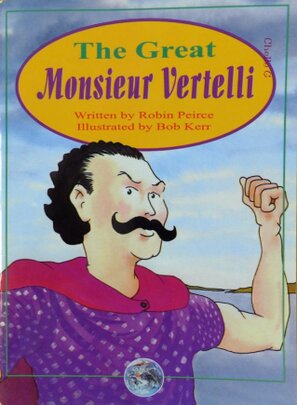
A modern-day children's book by New Zealand author, Robin Peirce, celebrates the walk of "The Great Monsieur Vertelli". (8)
In December, in Auckland, Vertelli was refused permission to walk on a wire stretched from the theatre across Queen Street, so he moved across to the s.s.Egmont and walked from the main to the foremast then, returning to the theatre, managed to convince a female spectator to make a wire crossing on his back.
By March 23, 1868, having conquered New Zealand, Signor Vertelli was back in Melbourne at the Princess Theatre.
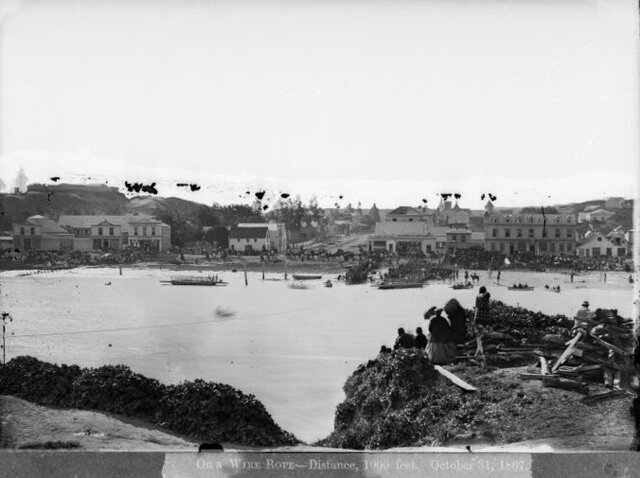 VERTELLI, NOT VERLETTI
VERTELLI, NOT VERLETTIA constant frustration in the researching of Vertelli's story, is the intersection of his activities with the "Verlettis", William and Charles, who were also trapeze artists and gymnasts, though not, it would seem, wire-walkers.
In Australia the names Vertelli/Verletti were occasionally mis-spelt in newspaper advertising. In New Zealand, however, when the Verletti trapeze troupe toured during 1869, the press was so indoctrinated with the name "Vertelli" that they repeatedly used the name incorrectly; to such a degree that one has to wonder if the Verlettis were deliberately capitalising off the earlier performer's fame. In either case, we will simply highlight that the brothers were no relation to John Morcom, that any reference to Vertelli in connection with Mr. Loyal or Md. Ella Zuila is almost certainly the Verletti brothers, and leave some more masochistic historian to unravel the mess.
1868 - Vertelli and the Japanese Troupe
The year 1868 would be pivotal in the evolution of Vertelli's career, though he mostly continued to present his accustomed wire-walking and acrobatic repertoire. Returning to South Australia in April, he remained there for several months, performing in many outlying towns.
A commentary in the Express and Telegraph (April 18, 1868) expressed concern about the safety of his exhibitions. "… with respect to the carrying of the child upon the Monsieur's back along the wire, we can but repeat our yesterday's comments, that it is most objectionable, and should not, in the name of humanity, be allowed. Would it not, we would ask, be an equal test of Vertelli's abilities, were he to carry a weight instead of the child? thereby doing away with the present risk to like and limb." The commentator was, of course, correct about the dangers involved; in October at Geelong, Vertelli's wire broke while the boy was on his back, but fortunately neither was harmed. What the news columnist did not understand was that the presence of danger was the precise reason why Vertelli's act drew an audience.
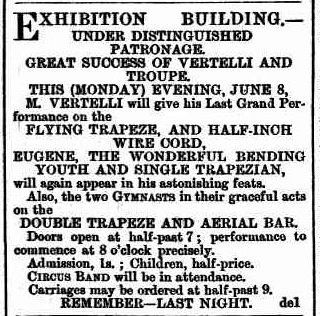
The change in John Morcom's career started in June, when he met up with a troupe of Japanese performers, the Tycoon Troupe, whose feats consisted of top-spinning, brick balancing, juggling and pseudo-juggling, walking on sheets of paper, somersaulting on the edge of two swords, slack-cord walking and other traditional skills. Along with the Lenton & Smith's Dragon Troupe, these Japanese performers were remarkable in that they were the first to tour internationally, as their nation gradually opened up to the Western world. Their performances were something completely novel to the general population.

Vertelli performed together with the Tycoon troupe at White's Assembly Rooms through July, and he was strongly influenced by the contacts he made, not just to the point of incorporating some of the routines into his own performances, but because in years to come he would be one of the first Western performers to travel to Japan. Magic historian, Mitsunobu Matsuyama, has written an excellent and lengthy account, "An Investigation of Magic in Japan after the Opening of the Country" (11) in which he examines Vertelli's time in that country from 1875-1876.
John Morcom, by August, was effectively performing not as a solo act, but as the head of a performance troupe. "Eugene" who is mainly referred to as a young male, but sometimes as a female "Eugenie", assisted in acrobatic feats. Mons. Le Page, when not on the aerial bar, performed the Davenport rope escape. Mons. Sams was seen with a roller skating act. Morcom took up performing the Japanese top-spinning routine, the top ascending along a fine thread, or along the edge of a sword. He demonstrated the apparently skilful feat of rolling a ball around the outer rim of a paper umbrella, and he performed the Butterfly Illusion.
This was one of the most beautiful of the Japanese Troupe's demonstrations; the "Butterfly Illusion" or Ukare-no Cho. (9) A piece of tissue paper is twisted into the shape of a butterfly (or several) and, with the aid of two hand-held fans, it is gently blown into the air, fluttering around, taking rest on the fans or on a group of flowers. In the usual finale, the single butterfly is held in the hand and fanned, exploding into a cloud of butterflies filling the air. In modern magicians' parlance, this visual finale is more commonly referred to as "Snowstorm in China", and performed as a stand-alone trick.
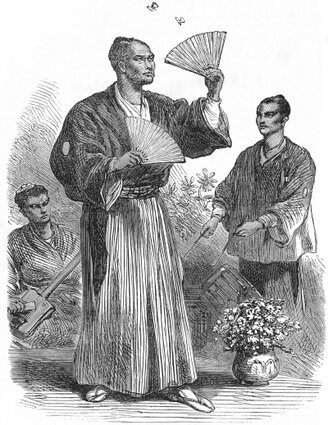
The Butterfly illusion is a wonderful combination of genuine juggling skill and a hidden secret that makes it a magician's deception; so for John Morcom to learn this trick may have been his first introduction to the art of magic. Curiously, the Japanese Troupe not only performed this illusion, they made a point of advertising that "every person honouring the Japanese with their presence will be instructed how to do the celebrated Butterfly Feat that caused such a sensation in Europe." An incongruous remark by the 'Border Watch' of August 26 in reference to a Vertelli performance was that "it so unfortunately happened one of the wings of the butterfly was broken, and as it could not be repaired at the Mount [Gambier], the butterfly illusion trick did not come off." Incongruous, as the feat did not depend on anything of a highly mechanical nature.
The fact is that no audience member could ever go home and replicate this trick. In speaking of his attempts to learn the feat, a modern-day magician, David Hirata, comments (10), "Ukare-no Cho is extremely difficult to perform … I was struck with how much engineering was required to assemble the workings .. simply preparing to practice the Ukare-no Cho requires a clear mind and steady fingers. A slight change in the fold of the tissue, or in the positioning of the hands on the fan during the performance can make the difference between a magical presentation of life, and a botched craft project … Now, after over a year of practicing the Ukare-no Cho, I'm nearing the level of perfection necessary to put it in front of a live audience."
Vertelli clearly discovered the difficulty of these tricks as, in the first few months, his performances were less than convincing. The Hamilton Spectator (September 2, 1868) slammed the magic and juggling portion of his show:- "As for the butterfly trick, it was simply a dead take-in and the only redeeming feature of the entertainment was that the grotesque blunder of Vertelli in attempting feats of skill with the Japanese top elicited such mirth as put the company in good humour with themselves. For our part …. we hardly know whether to regard the top-spinning business as a miserable joke, or a deliberate imposition." Fortunately, as these feats remained in his show, Morcom gradually learned the skills required and became quite expert in their performance.
Vertelli was in Melbourne at the Colosseum during early October, before crossing the strait to Tasmania for performances at Launceston, including a display at the South Esk river near Cataract Gorge when he walked several times over the wire, walked blindfolded, and then carried a man on his back.
Middle Years 1869-1874
Because Vertelli had become an institution in the southern states of Australia by 1869, we will not attempt to detail his every appearance and engagement. Suffice to say that he travelled constantly and widely, presenting a similar repertoire of feats, occasionally with a major wire-walking stunt which drew large crowds. As he progressively enlarged his repertoire of conjuring and novelty skills, the newspapers most often reported good audience numbers, and were in general complimentary about his performances. This cannot be said about many of the other touring magicians who preceded him; poor weather, low economic conditions and suspicion of performers as 'low characters' often resulted in a disappointing attendance.
Morcom was still in Tasmania as late as May 1869, and he walked a length of some 300 feet from Rosny to Kangaroo Point in Hobart in March. Early May saw him advertising his benefit night, "Previous to his departure to India", though that trip did not take place. Returning to Melbourne in June, he was assaulted from behind on the street and, though well strong enough to defend himself, allowed the ruffian to escape, so as not to further alarm the lady with whom he was walking. August saw Vertelli in Ballarat, expanding his troupe with the addition of "Master Frank Barry, the youthful Clown and Irish Comique", and Professor Pirie the Ventriloquist. As an indication of his physical strength, he had also added the feat of lifting two 56lb weights above his head with his arms fully outstretched, and lifting 28lb weights hung from his little fingers. In November, at Albury, he crossed the river Murray near the Hume bridge.
February 1870 saw Vertelli in Bendigo, where his repertoire was gradually expanding; he now included the stunt of chewing on a wad of burning rope tow, spitting sparks from his mouth and then drawing out yards of ribbon. His protégé Frank Barry performed on the single trapeze.
A Lyceum Theatre appearance on February 24 promoted "Chapman the Miraculous" also on the bill, and this may have been W.A.Chapman (12), associate and imitator of the great Robert Heller. Mitsunobu Matsuyama (11) notes the similarity of trick titles such as "The Witch's Pole" and "Raising the Wind" in both Heller's and Vertelli's programmes. Since Heller had a highly successful tour of Australia between 1869-1871, his magic must have been an influence. In May, the Bacchus Marsh Express also mentioned "collecting coins in a hat, together with a little ventriloquism … very good."
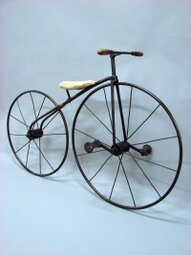
Returning to South Australia in November, Vertelli now introduced another innovation - riding a Velocipede across a wire, which possibly he first ventured in May when an advertisement referred to Jean Vertelli and "crossing the lake on the bicycle".
Now for the first time, newspapers started referring to "Vertelli's Wonders - Temple of Magic" as the primary attraction. Though Vertelli would continue to feature his acrobatics and strength feats, an evolution was taking place, and given the dangers of his acrobatics, even for a relatively young man of thirty, this was a sensible move. The consideration of personal safety was more important when, in 1871, he apparently started a family. Even so, he never completely abandoned his wirewalking; as late as 1881 in Sacramento, his wire feats were still included in advertising.
The full family history is difficult to trace, but it seems John married a Australian-born woman named (19) Annie, with whom he had a family of some six children, none of whom lived past 1900. His son Henry or Harry seems to have drowned in the late 1890s.
The "Temple of Magic", simply a fancy title for "show", opened in the town of Kapunda, at James Crase's Assembly Rooms. Here, he introduced the "Ring Trick" or the Chinese Linking Rings, and another feature of the show was allowing the local boys to put on roller skates and blunder about to the amusement of the audience. Advertisements referred to the show's agent as J.Morcom, and while this may have been John Morcom, it could well have been his brother, James.
JAMES MORCOM
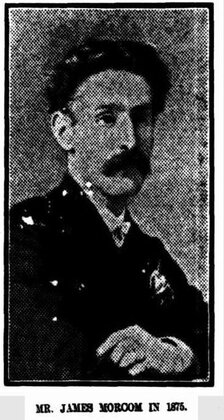
John's brother James, himself an acrobat and champion rifle shooter, also had a career working as an Advance Manager for a variety of performers, some of whom were magicians. In a series of articles written for the Adelaide Register (3) in 1916/17, he mentions having travelled with:-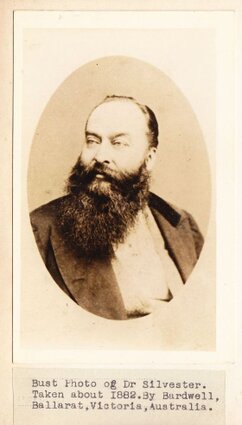

- Professor Nash the mesmerist and electro-biologist, seen in Australia in 1871
- Mickey Pynn the Australian Tom Thumb (see below) with John Morcom, 1871
- Rayner's Panorama of the American War c. 1876/77. Possibly J.C.Rayner, manager of the Adelaide Theatre Royal.
- Mr and Mrs George Case, actors. Grace Egerton performed with a 'Protean Cabinet' illusion and rapid costume changes. James was with them as manager during a tour of New Zealand in 1875.
- The Carandinis, opera singers.
- Burton's Circus.
- The Fakir of Oolu. The Fakir was the original British performer Alfred Silvester, whose family continued to perform in Australia into the 1900s. Newspaper reports confirm that James acted on Silvester's behalf in 1875 and 1876.
James recollects having once pasted an advertising handbill on a drunken man's back as he tottered around the streets, and an occasion on which the train he was travelling on with Alfred Silvester's equipment was derailed. It appears that he retired from show business in order to return to Adelaide and manage the Temperance Hotel, when his father Samuel became insolvent. James lived in Halifax Street, Adelaide, until his death in December 1917.
MICHAEL PYNN, THE AUSTRALIAN TOM THUMB
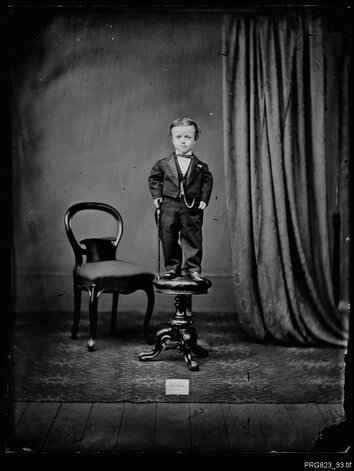
Michael Pynn, from State Library of South Australia
Catalogue record SLSA referencePRG 823/93
Catalogue record SLSA referencePRG 823/93
While in Kapunda, a mining town north of Adelaide, Vertelli was introduced to Michael "Mickey" Pynn, a Kapunda local (13). Pynn (sometimes reported as "Pinn") was a little person, or in the terms of those days, a midget of proportionate body. His height is given variously as thirty or thirty-four inches. This was regularly claimed to be some inches shorter than the famous Charles "Tom Thumb" Stratton (14) of Barnum fame who visited Australia in 1870; but most documentation of Stratton gives his height as twenty-five inches.
Mickey Pynn was (again, depending on the report) either 15 or 17 years old, and on July 30, 1870, the South Australian Register reported that "he is double jointed, and not being able to walk very freely, his smallness has not come conspicuously before the Kapunda public. His father is a labourer, living at Baker's Flat. Hearing of the arrival of the General [ie, Stratton], some of Pinn's acquaintances have provided him with an appropriate suite of clothes, wellington boots &c., and on Wednesday he went to Adelaide for the purpose of presenting himself to our small, though distinguished American visitor."
On August 26 the Kapunda Herald announced that "South Australia's Tom Thumb" would hold a Levee at Crase's Rooms, and that he had made arrangements to go the rounds of the Colony on his own account. Whether he had already met Vertelli is unclear, however shortly after Vertelli visited Kapunda in December 1870 the two were travelling together. Mickey Pynn was thereafter billed as the "Australian Tom Thumb".
He was not the only person touring under this name; John David Armstrong (1857-1943) (15) made appearances in Australia, the UK, South Africa and the United States. A Samuel Burgess, under the same "Tom Thumb" billing, was involved in an assault case in Victoria (April 1871) but is not noted anywhere else.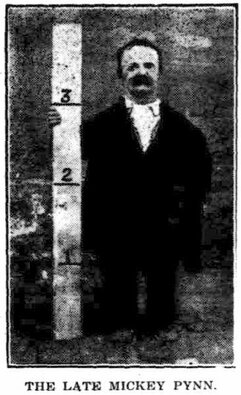

The usual tradition for people of physical "curiosity", who did not fall into the unfortunate category of "freak show" exhibits, was to present comic songs and recitations, cavort, be admired for their novelty, and in general to be cheeky and precocious chappies who amused their audiences.
Initially capitalising on the visit to Australia by Charles Stratton at exactly the same time, Pynn is said to have gone on to work as a circus clown, passing away in Sydney, June 1929. I have not seen any proof that he travelled outside Australia.
Vertelli received a critical review at Clare (16) which, aside from complaining that he did not perform all the magic shown on his handbills, mentioned that as of December 1870, Pynn's guardians had declined to allow him to leave on tour, and so he was not present as advertised. Vertelli returned to Clare in March, with Pynn, but the newspaper was no less critical, comparing him unfavourably to "a burlesque on Hellerism".
Touring 1871 - 1874
That hurdle overcome, Vertelli's show consisted of himself, Mickey Pynn, and Frank Barry who was now grandly advertised as having come from India. Barry rode his velocipede across a rope. Miss Bessie Colville performed some Scottish dancing, while Vertelli's "Somatic Conjuring" now included the "Witch's Pole" (the Rising Cards trick), "Wonderful Punchmakers", "Aerial Money or Raising the Wind", the Egg Bag, Inexhaustible Bottle, producing "tinware from a hat", and the "Dancing Skeleton" following some titles copied from Robert Heller. The show concluded with Vertelli on the wire with his wheelbarrow, and baskets which he may have worn on his feet. Vertelli was moving busily around South Australia and Victoria, including the towns of Adelaide, Gawler, Port Adelaide, Wallaroo, Hamilton, Clare, Auburn, Moonta, Morphett Vale, Freeling, Glen Osmond and Hindmarsh.
The South Australian Register (January 17, 1871) remarked that Mickey Pynn "is perfectly formed, and has a very pleasing and intelligent countenance, far beyond that of any of the dwarfs we were some time ago visited by. His artless airs caused much amusement." The Kapunda Herald (March 2) said he "is a pleasing simple little fellow, whose greatest feat is to scratch his head like a bear with his toes - his knees being kept straight during this interesting operation …. rather of a serious turn of mind, and has a look of great gravity previous to turning a summersault."
A review by the Gawler Times on February 3 correctly mentioned that "In some respects the most wonderful part of the performance was Mr. Barry's Second Sight, similar to that introduced here first (we believe) by Mr. and Miss Heller. Mr Barry and Mr Vertelli did it nearly as well to all appearances; a number of coins and other articles were collected from the audience and deposited in a little black bag. Mr. Barry, who was blindfolded and his head covered with a shawl, sat on the platform, Mr. Vertelli being about ten yards from him on one of the front seats. Mr. Barry then described one by one, and correctly, every article as taken out of the bag by Mr. Vertelli. We don't know whether it is done by ventriloquism on the part of Vertelli, but if so it is still very clever." The second sight routine, doubtless inspired by Heller, remained in the Vertelli repertoire for many years, and he would perform it with his wife in the United States.
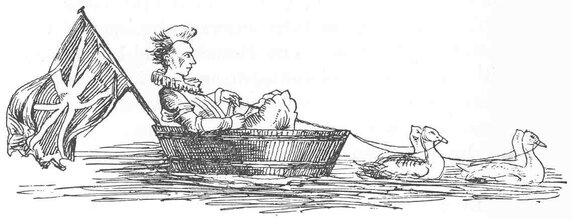
During September and October the show was not seen, but by November Vertelli was in Sydney, featuring exclusively his blindfolded wire ascent, at the Royal Victoria Theatre. One strong reason may have been the presence nearby, at the Prince of Wales Theatre, of Madame Cora De Lamond, whose full-evening magic show was far greater in scale and magnificence than his own. However, by December he was again conducting his "Magic Temple" at Clontarf, with Frank Barry, and with Mr. Charles Verletti on the trapeze. In a wonderful publicity stunt which would serve him well in future years, Vertelli harnessed six geese to a wooden tub, and was drawn across Middle Harbour and back. This was a stunt featured in England as early as 1844 by the clown Thomas Barry.
1872 saw the Vertelli troupe move into New South Wales, including Goulburn, Braidwood and the Illawarra region (where he walked over the Belmore Basin), with Eugenie the lady gymnast, Frank Barry on trapeze, Michael Pynn possibly for the final time, and Vertelli billed as The Blondin of Australia. His top-spinning was now receiving regular praise - "… first introduced by the Japanese, was done in a marvellous manner, the top being made to travel along a piece of cotton. In fact. M. Vertelli seemed to be able to make the top spin anywhere and anyhow. Another of the Japanese tricks, the butterfly illusion, was done in a manner which equalled if not surpassed those clever conjurors."
At Newcastle from June 13, Vertelli wire-walked across from Market wharf across Market Street , before performing in the Victoria Theatre, though this appears to be an earlier venue, possibly in Watt St (17), than the 1876 Victoria Theatre, the oldest surviving heritage theatre in the state, (18) which is currently undergoing full restoration in Newcastle.
At this point, Vertelli vanishes from the newspapers entirely. Where he could once be tracked around the country by his advertising and press commentary, there is no mention for the remainder of 1872, all of 1873, and up until February 1874. We are left only with speculation; no evidence can be found that he left the country. It is possible that if John Morcom was engaged in raising a young family (or that any of those children died young, as was common), he might have retreated from travelling in order to look after them.
Suddenly on February 14, 1874, Vertelli reappears, for the first time travelling in Queensland. His entertainment at the Warwick Town Hall featured Miss Eugenie, and her constant presence raises the question of whether there was any family connection, (in fact, his wife?)
In May at Gladstone, and Pene's Cremorne Gardens in Rockhampton, Vertelli performed all his signature stunts, including sailing down the river in a geese-drawn tub, ventriloquism, magic, grand blindfolded ascent on the wire, the high rope while carrying a lady on his back, and his "Dancing Skeleton" which he now cheekily titled "Tom Thumb Ghost". In June the Calliope school committee had to postpone their meeting because of poor attendance; everyone had gone to see Mons. Vertelli. By October he was at Martin's Assembly Room in Mackay, where he remained to a fortnight. Bowen residents had a visit in mid-November. In December the post office advertised some mail being held for "Madame Vertelli" at Rockhampton.
Early in 1875, Vertelli is noted performing at the town of Milchester in January and the Olympic Theatre, Townsville on January 30. From that date, John "Vertelli" Morcom is seen no more in Australia. During a mere ten years, he had created a career for himself, travelled widely, engaged in any number of successful and dangerous wire-walks, and reinvented himself as a magician.
JAPAN AND CHINA
We are left to track Vertelli's movements through scarce mentions in English-language newspapers. It seems that he had travelled up to the far North as a jump-off point, and left Australia on an overseas tour which included China, and certainly Japan.
If we go by the routes established by Prof. Hennicke, and in later years by Dr. Richard Rowe, Murray Walters, Percy Abbott and Les Levante,the most likely countries to visit would have been the Philippines, China, Burma and India, with an end destination in England. What we can be sure of is that in 1875-1876, he was in Japan. Thanks to the research of Mitsunobu Matsuyama (11) we know that Mr and Mrs Vertelli appeared at the Kaihoro Chinese Theatre from November 18-26 , 1875, and then at the Gaiety Theatre, Yokohama, in both December 1875 and December 1876. They had a young child with them, who would have been the son, Henry Morcom.
Between these December dates, a "Jon Marukomu" was reportedly performing through the country, at Kyobashi, Fukagawa, Asakusa, Tokyo and Ushigome, bringing with him a highly-influential western style of performance which was one of the very earliest in the nation's history, during the 1868-1912 Meiji period, along with magicians Harry Black and Joseph Vanek. It was unusual at this time for performers to appear away from the Yokohama 'foreign concession', both because of regulations restricting travel, and the lack of public transport facilities at that time, after the opening of Japan to the world in 1866.
The reference to "Marukomu" can be seen as a phonetic translation of the name "Morcom" - and some other references to a magician "Bataria" may likewise have been an attempt to convert the difficult name "Vertelli" into a Japanese format which lacked the sounds for "V" and "L".
Vertelli must have made use of the contacts established during his time with the Japanese Troupe in Australia, and he may have been guided by a Japanese acquaintance.
In the same way that ground-breaking performers such as Robert Heller influenced Vertelli, his magic routines in Japan likewise left behind a generation of performers who adapted and copied his tricks and style. Apparently Vertelli had the apparatus to perform the (Robert-Houdin) "Aerial Suspension" during his Japan tour, and it was likely purchased by performer Chogyokusai when they left the country.
A brief notice in the S.A.Register (Jan 1877) stated that Vertelli was in China. Nothing more is known of that tour at present.
UNITED STATES
The Vertellis arrived in San Francisco on October 02, 1877. Although this period is briefly documented, it formed the longest part of Vertelli's career, another twenty or so years.

The Morcom family home was at University Avenue, Oakland, West Berkeley in California, and after 1900 at 1641 San Pablo Avenue. From 1880 until 1896 Vertelli's travels can be tracked by intermittent newspaper advertisements for both solo performances and Variety Bills spread around the country; starting on the West Coast and then from 1887 more widely.
Magic, ventriloquism and the "Second Sight" act with his wife continued to be the main features of the show and, on occasion, Henry (possibly referred to as Harry) appears on the bill with "Pictures in Fire". Wire-walking still forms part of the show, though on occasion this is done by a partner, such as "Miss Rowland". In the 1890s, Punch and Judy and marionette entertainments are added to the repertoire, and the publicity gimmick of giving away prizes at each performance is a regular feature.
Skipping through the few available news clippings, these dates and states are recorded:
1880 - November at Squire's Opera House,Seattle ("last from Woodward's Garden, San Francisco")
1881 - January "touring the islands of the San Juan archipelago … then to Port Townsend. Has recently visited other points on the Sound.
1881 - Albany OR., Opera House
1881 - c.April in Vancouver
1881 - September at Morgan's Amphitheater and Menagerie, Sacramento CA. Variety bill ; with magic and a wirewalk by Vertelli.
1882 - Vertelli replaces an injured wire-walker at Albany OR
1882 - September 2, Portland OR.
1882 - November 24, Port Townsend W.T. with Mrs. Vertelli and Master Vertelli and Johnny Carter (comedian).
1882 - November 30, Yesler's Hall, Seattle W.T.
1883 - early August for at least six nights at Atlantic Gardens, Sacramento CA.
1888 - Jan 22 with the Denver Musee and Theatre as "Professor Vertelli and his Royal Troupe of Marionettes".
1888 - from April 29 at The Museum, Wichita KA with Madame Vertelli in Second Sight.
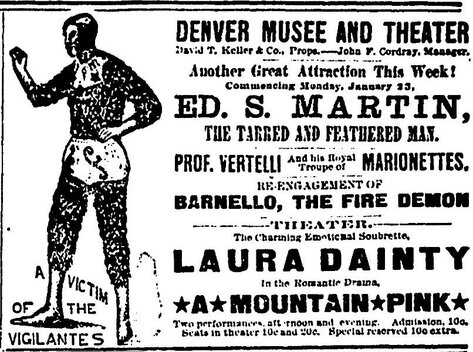
In May 1888, a Kansas newspaper gave Vertelli a stinker of a review, referring to him as "Vertelli or Vermicelli or some other fellow with an American tongue and an Italian name." The reviewer was happy enough to view the free wire-walking exhibit, but did not go to the paid entertainment which followed, and which he claimed was "declared by the few who witnessed it to have been a vile performance." It seems most likely that this completely out of character review was caused by the writer having a bad hair day.
The South Australian Register reported, on January 13, 1890, that on October 3 previous, Vertelli had accomplished his feet of driving six geese, harnessed to a tub, across the Niagara River. On October 11 he went further, crossing the same river below the falls on a wire with his wheel barrow.
1893 - March 8, Bridegton NJ.
1893 - April 22, Vertelli's Museum of Wonders and Carnival of Novelties opens at Middletown, DEL. with Harry performing 'pictures in fire'. The Middletown Transcript said "… presenting one of the best shows we have ever seen for a dime … strictly moral and just such as show as delights the little ones … you'll not regret the price of admission."
1896 - April 14, Orpheum Theatre, Los Angeles CA - "little standing room left … one of the largest houses of the season … a splendid vaudeville bill was presented, opening with the celebrated Vertellis, whose pictures of five royal marionettes and ribbon illusion suggested a knowledge of the black art."
FINAL CURTAIN
Though hardly an old man, John Morcom's health began to catch up with him in the late 1890s. The magazine for magicians, "Mahatma", reported in December 1899 that "Proff. J.Vertelli, the Australian illusionist, who has been confined to his bed at his home in West Berkeley, Cal., since September 9th, 1898, is slightly improving." A full year's indisposition must have been serious indeed, and his 1914 obituary would mention that both his feet had been paralysed. As well, somewhere around 1898 or a little earlier, tragedy had struck when his son Harry, aged 22, was drowned in San Francisco Bay while duck shooting. (21)
By 1902, the "Sphinx" magician's magazine had to report that Vertelli was "an invalid from rheumatism and will probably never appear again … the sad death of his son Harry (who was a magician and fire king) some two years ago by drowning, has aided in the general breakdown of Prof. Vertelli."
How sadly ironic that such an athletic and strong performer should be crippled by rheumatism, but Vertelli was not yet down for the count. In the January 1905 "Sphinx" he advertised his magic outfit for sale, including Marionettes, Shadowgraphs, Illusions etc. Though unable to use his feet, he had already evolved his career in the direction of providing astrological services and card readings, and was able to make a fair living.
Annie Morcom passed away in 1912 and, on January 8, 1914, John 'Vertelli' Morcom followed her.
Friends wrote in his obituaries (22) that "he was a very honourable man in all his dealings, strictly temperate in his habits, cheerful in the most discouraging conditions, and has left to the world the record of a life well lived."
REFERENCES
(1) Two of the members of the Leotard Troupe were brothers named Edwin and Fred Hodgkinson.
(1a) See 'The Wizard of the Wire - the story of Con Colleano' by Mark St Leon for more on wire-walking in Australia. Aboriginal Studies Press, Canberra 1993 ISBN 0 85575 246 7
(2) The Morcom family history is more extensive than we can cover here; there were other family but John and James are our focus. Daughter Mary and son Samuel Morcom were also born in Cornwall, and Samuel became a noted cricketer. William was a top swimmer in South Australia, Harry was a 'backwards runner'. James, among his other talents, was a champion rifle shooter. https://en.wikipedia.org/wiki/Samuel_Morcom
Main sources used for family details of John Morcom come posthumously from
- The Chronicle (Adelaide, SA) of November 20, 1930 p.52
- The Sphinx magazine (for magicians), obituary in the February 1914 issue.
See also ref (20)
(3) James Morcom wrote several articles with his recollections, for the Adelaide Register, on December 16, 1916, January 13 and January 18, 1917.
(4) A tale of "Pioneering Days - Old Colonial History" gives considerable detail on the Morcoms. Adelaide Chronicle, November 20, 1930 p.52
(5) Adelaide Express, November 7, 1864 p.2
(7) Installed at Curtis Park in Armidale. A plaque in Vertelli's honour once existed earlier, but was apparently removed at some stage. See https://www.abc.net.au/local/audio/2012/12/03/3645932.htm
(8) 'The Great Monsieur Vertelli', by Robin Peirce, ISBN 10: 0780270622 / ISBN 13: 9780780270626 Published by the Wright Group, 1996
(9) Many contemporary performances of this classic trick can be seen:-
(11) "An Investigation of Magic in Japan after the Opening of the Country", a thorough and detailed essay by Mitsunobu Matsuyama. Published in the journal of the Conjuring Arts Research Center, "Gibeciere". The full essay is published across ten instalments. Part IV, which covers Vertelli's time in Japan, is in the Summer 2008 issue (Vol.3 No. 2) https://conjuringarts.org/
(12) Wiliam Adam Chapman is, at May 2020, yet to be fully documented on this site, but he apparently worked for, then split from, Robert Heller, going on to perform a close copy of Heller's material. He toured with mixed success in New Zealand but may have had a sad ending, for in September 1876 the Australasian noted "the Wizard Chapman is here in destitute circumstances. He opened to a good audience some weeks ago, but he made some remarks which offended his patrons, and he has not had a good house since."
(16) Northern Argus, December 16 1870
(19) These details are extracted from the U.S. census of June 1900 against the name John Morcom in Berkeley CA., which recorded that the couple had been married for 29 years. Data recorded - "Mother of how many children" = 6, but "Number of these children living" = 0.
Australian marriage and birth records have not been located. See also (20).
(20) The US Census of 1900, for Berkeley in Oakland Township, is the source of most of the documented information here.
Further information about "Annie" (maiden name not known) can be found at
"BIRTH: ABT 1850 in NSW AUS.
US Federal Census 1900: age 49, wife, b. Australia, parents born in England, married 29 years, had six children, non-living, immigrated 1876. No record of Annie's marriage to John or their six children has been found in the Australian records .
US Census 1910: Annie MORCUM, 59, head, married 38 years, born in ?NSW? , parents born in England, arrived in USA 1877. Mother of eight children, none of them living [Could Annie have been counting miscarriages and stillbirths] - Death: 1912"
Summary notes about John "Vertelli" Morcom : https://morcom.one-name.net/pp268.htm#i8239
John's son Henry : https://morcom.one-name.net/pp210.htm#i20820
And a Morcom family tree chart at https://morcom.one-name.net/ch14.htm#i20819
(21) Confirmation cannot be located regarding Harry's death, but it is mentioned contemporaneously by friends in the magic press.
